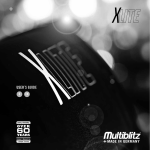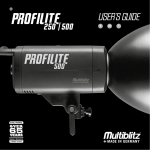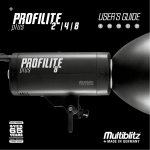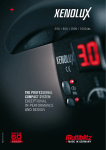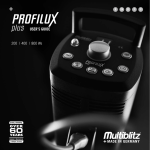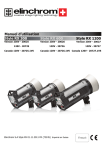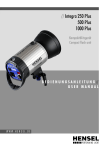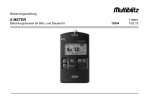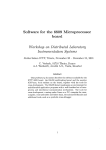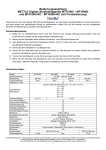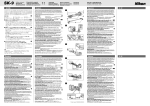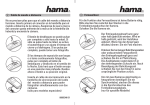Download USER`S GUIDE
Transcript
USER`S GUIDE D EN FR D USER`S GUIDE IR Empfänger/ Fotozelle Leistungsregler Display Leistungsanzeige, Anzeige Funkempänger “aktiv” & Anzeige “stand-by” IR Empfänger/ Fotozelle An/Aus und Kanalwahl für Funkempfänger Test und Aktivierung des Funkempfäners LED´s Anzeige Funktion An/Aus & “Stand-By” Gerät An/Aus Akkustische-/ optische Abblitzkontrolle Synchronbuchse Halogen An/Aus (An = Proportional) Halogenlicht 100% An/Aus Netzsteckdose/ Sicherungslade/ Ersatzsicherung Vielen Dank das sie sich für MULTIBLITZ entschieden haben, wir hoffen das ihnen die Arbeit mit diesem hochwertigen Qualitätsprodukt Freude bereiten wird. MULTIBLITZ Blitzgeräte werden ohne Ausnahme in Deutschland konstruiert und hergestellt. WICHTIGE HINWEISE ZUR PFLEGE UND INSTANDHALTUNG! Lesen Sie diese Bedienungsanleitung genau durch bevor sie dieses Produkt anwenden. Die Blitz-/ und Halogenröhren sowie Metallreflektoren werden im Betrieb sehr warm und können bei nicht sachgerechter Handhabung Verbrennungen verursachen. Das Öffnen des Gerätes könnte lebensgefährlich sein! Öffnen sie das Gerät unter keinen Umständen selber! Der Service sollte nur von einer autorisierten MULTIBLITZ Vertragswerkstatt durchgeführt werden. Decken Sie nicht die Ventilationsschlitze ab. 2 Setzen Sie niemals Filter, Diffusionsmaterial oder ähnliches direkt auf die Blitz-/ oder Halogenröhre. Das Gerät darf auf keinen Fall Wasser, auch nicht Spritz- oder Tropfwasser, ausgesetzt werden. Das Gerät darf nicht mit ungeregelten Benzin- oder Dieselgeneratoren betrieben werden. Bei ständigem Gebrauch sollte das Gerät einmal jährlich in einer autorisierten MULTIBLITZ Vertragswerkstatt überprüft werden. Zur Vermeidung einer möglichen Beeinträchtigung der Umwelt oder der menschlichen Gesundheit darf dieses Produkt nicht in den Hausmüll gegeben werden, um zu gewährleisten, dass es in einer umweltverträglichen Weise recycelt wird. Wenden Sie sich für Informationen zu Entsorgungseinrichtungen an die zuständige Behörde oder das Geschäft, in dem Sie dieses Produkt erworben haben. XLite BEDIENUNGSANLEITUNG 1. Formierung der Blitzkondensatoren Die Blitzkondensatoren müssen unbedingt formiert werden wenn, 5. Funk-Synchronisation Die Blitzauslösung des Geräts kann über einen Funkauslöser (Code: MURAS T, separat erhältlich) erfolgen. Hierbei wird der Funkauslöser auf den Blitzschuh der Kamera aufgesteckt. Das Gerät/die Geräte blitzt/blitzen dann synchron beim Auslösen der Kamera ab. - das Gerät zum ersten mal in Betrieb genommen wird. - das Gerät 3 Monate nicht in Gebrauch war. Formierungsvorgang: 1. Gerät an das Netz anschließen und einschalten. Bitte entnehmen sie Informationen zur richtigen Handhabung des MURAS T Funkauslösers der entsprechenden Bedienungsanleitung. 2. D ie Leistung in Abständen von 15 Min. über die fünf Blenden (1.0 -5.0) erhöhen. 3. Gerät während der Formierung nicht „abblitzen”!!! 4. Gerät in diesem Zustand 1 Stunde eingeschaltet lassen. Programmierung der Empfangskanäle: Im Gerät ist ein 16 Kanal Funkempfänger fest eingebaut, Sender/Funkauslöser und der im Gerät integrierte Empfänger müssen auf denselben Kanal eingestellt werden. Mit folgender Tastenkombination kann der Funkempfänger aktiviert und auf den gewünschten Empfangskanal eingestellt werden: Nach 1 Stunde sind die Blitzkondensatoren formiert und das Gerät kann in Gebrauch genommen werden. 2. Inbetriebnahme Nehmen sie die Schutzkappe vom Gerät ab indem sie das ReflektorSchloss an der Unterseite des Geräts in Richtung des Bedienungs-Panels schieben, dann die Schutzkappe gegen den Uhrzeigersinn drehen und herausnehmen. Halogenröhre Setzen sie die mitgelieferte Halogenröhre in das Gerät ein, siehe 7. “Wechseln der Halogen- und Blitzröhre”. Netzanschluß Das Gerät ist von Werk aus für den Betrieb an einem Stromnetz von 220-240 V/50-60 Hz Wechselspannung vorgesehen. Vor dem Anschluss an das Stromnetz ist sicherzustellen, dass die Netzspannung und die Angaben auf dem Typenschild übereinstimmen. Verbinden sie das Gerät über das mitgelieferte Netzkabel mit einer Steckdose, der mittlere Dezimalpunkt des Displays leuchtet und das Gerät befindet sich im „stand-by” Modus. Gerät mit dem Schalter „I-0“ einschalten. 3.Synchronisation über Kabel Das mitgelieferte Synchronkabel (Code: MASYG) in die Synchronbuchse einstecken und mit der Kamera verbinden. Beim Einsatz mehrerer Geräte genügt der Anschluss eines Gerätes, alle anderen lösen verzögerungsfrei über den eingebauten IR Empfänger/die Fotozelle aus. Hierbei müssen die IR Empfänger/die Fotozellen aller genutzten Geräte aktiv sein. 4. Optische-Synchronisation 1. Das Gerät kann auch ohne Synchronkabel durch einen IR Fernauslöser (Code: MUSEN, separat erhältlich) ausgelöst werden. Hierbei wird der Fernauslöser auf den Blitzschuh der Kamera aufgesteckt, der IR-Empfänger/die Fotozelle des Geräts muss über die entsprechende Taste angeschaltet werden. Das Gerät blitzt dann synchron beim Auslösen der Kamera ab. Beim Einsatz mehrerer Geräte müssen die IR-Empfänger/ die Fotozellen aller genutzten Geräte aktiv sein. - D ie „Test“ Taste ca. 3 sek. gedrückt halten (ggf. gibt das Gerät ein akustisches Signal ab, abhängig davon ob die akustische oder optische Abblitzkontrolle aktiv ist), das Gerät blitzt einmal ab, das Symbol für die Kanalanwahl „CH“ erscheint auf dem Display, jetzt muss die Taste wieder losgelassen werden. - N ach ca. 2 sek. wechselt das Display mit einem kurzen akustischen Signal von „CH“ nach „--“ (= Funkempfänger nicht aktiv, kein Kanal eingestellt), da ab Werk kein Empfangskanal eingestellt und der Empfänger nicht aktiv ist. - D urch Drehen des Leistungsreglers kann jetzt der gewünschte Empfangskanal (z. Bsp. „12“ = Kanal 12) eingestellt werden. Die Anwahl des Kanals durch Drücken der „Test“ Taste bestätigen, das Display wechselt wieder zur Leistungsanzeige. - D er Funkempfänger ist jetzt aktiv und arbeitet nun auf dem angewählten Empfangskanal. Wechseln zwischen Empfangskanälen: - Die „Test“ Taste ca. 3 sek. gedrückt halten (ggf. gibt das Gerät ein akustisches Signal ab, abhängig davon ob die akustische oder optische Abblitzkontrolle aktiv ist), das Gerät blitzt einmal ab, das Symbol für die Kanalanwahl „CH“ erscheint auf dem Display, jetzt muss die Taste wieder losgelassen werden. - N ach ca. 2 sek. wechselt das Display mit einem kurzen akustischen Signal von „CH“ auf den eingestellten Kanal (z.Bsp. „07“ = Kanal 7), durch Drehen des Leistungsreglers kann jetzt ein anderer Empfangskanal (z.Bsp. „15“ = Kanal 15) eingestellt werden. Die Anwahl des Kanals durch Drücken der „Test“ Taste bestätigen, das Display wechselt wieder zur Leistungsanzeige. - D er Funkempfänger ist weiterhin aktiv und arbeitet nun auf dem neu angewählten Empfangskanal. 3 D USER`S GUIDE XLite BEDIENUNGSANLEITUNG 6. Wechseln der Lichtformer Lichtformer in das Bajonett einsetzen und mit Drehung im Uhrzeigersinn zum Einrasten bringen. Lösen in umgekehrter Reihenfolge. Reflexschirme sind nur mit dem Schutz- und Schirmreflektor (STUSCH) verwendbar. Die Halterung für Reflexschirme ist in den Schutz- und Schirmreflektor integriert. 7. Wechseln der Halogen- und Blitzröhre Gerät durch gleichzeitiges Drücken von Taste „I-0“ und „TEST“ aus schalten und „abblitzen”. Dann den Netzstecker ziehen. Blitzt das Gerät nicht ab, mind. 45 min. warten damit der Blitzkondensator entladen wird und so ein gefahrloses Arbeiten an der Blitzröhre möglich ist. Lichtformer vom Gerät entfernen. Halogenröhre nach links losdrehen und nach vorne herausnehmen. Neue Halogenröhre nach rechts eindrehen. Herstellerinstruktionen in der Verpackung beachten. Blitzröhre am Glasrohr (die Elektroden nicht berühren) nach vorne herausziehen. Neue Röhre vorsichtig einsetzen, dabei muss die Zündklammer das Glasrohr der Blitzröhre umfassen und Kontakt zum Zünddraht haben. allerdings nur unter extremen Umständen erreicht, z. B. bei Umgebungs temperaturen von über 40°C mit gleichzeitiger, direkter Langzeitsonneneinstrahlung und hoher Blitz-Anzahl. Bei gängigem Studiogebrauch wird eine Überhitzung des Gerätes nicht eintreten. 9. Sicherungen Zum Wechseln der Sicherungen, Gerät ausschalten und vom Netz trennen. Einen kleinen Schraubendreher hinter dem oberen Teil der Sicherungslade ansetzen und diese nach vorne herausdrücken. Die Gerätesicherung befindet sich im hinteren Teil, die Ersatzsicherung im vorderen Teil der Sicherungslade. Defekte Sicherung ausschließlich durch gleichwertige Sicherung ersetzen: 220 - 240 V = T 4 A 8. Automatische Temperaturüberwachung Das Gerät ist mit einer Temperaturüberwachung ausgerüstet die den Blitz und das Halogenlicht ausschaltet sobald eine Temperatur von ca. 50°C im inneren des Gerätes überschritten wird. Nachdem das Gerät abgekühlt ist gibt die Temperaturüberwachung Blitz- und Halogenlicht wieder automatisch für den Gebrauch frei. Temperaturen von ca. 50°C werden XLite FAQ Warum funktioniert die Auslösung des Geräts mit einem Synchronkabel nicht? Überprüfen Sie ob das Kabel richtig in den Buchsen des Geräts/ihrer Kamera eingesteckt ist. Warum funktioniert die Auslösung des Geräts mit meinem RS2 Funkauslöser nicht? Überprüfen sie ob der Empfangskanal des Geräts mit dem Sendekanal des Funkauslösers übereinstimmt und ob der Funkempfänger im Gerät aktiviert ist. Siehe Seite 3, Punkt 5. Warum funktioniert die Auslösung des Geräts mit meinem MUSEN Infrarot-Auslöser nicht? Überprüfen sie ob der Schalter “IR Empfänger/Fotozelle An-Aus” aktiviert ist. Warum erwärmt sich die hintere Oberseite des Gehäuses im „stand-by“ Modus leicht? Auf dieser Seite ist das Netzteil des Geräts verbaut. Systembedingt wird es im „stand-by“ Modus handwarm. 4 Warum blitzt das Gerät manchmal ab wenn ich in kurzen Zeitabständen die Leistung herunterregle? Das Gerät muss jedes mal sobald es heruntergeregelt wird überschüssige Energie abbauen, dies geschieht durch Abblitzen. Kann ich mein/e XLite Gerät/e an einem Multiblitz PROPAC 1 oder PROPAC 2 Akku betreiben? Nein, die Geräte dürfen nicht an den PROPAC Akkus betrieben werden. XLite Technische Daten XLite 500 + BLITZENERGIE, Ws: 500 + NETZSPANNUNG, V: 220 - 240 + LEITZAHl, 1 m, ISO 100, Reflektor RINOS 2/50°: 64,0 + Blende, 1 m, ISO 100, Reflektor RINOS 2/50°: 64,0 + VARIATIONSBEREICH, Blenden / Ws (Regelbar in 1/10 Stufen): 5/ 31,25-500 + BLITZFOLGE, sek: P 1/16 = 0,5, P 1/1 = 1,7 + Blitzdauer t 0.5, sek: P 1/16=1/500, P 1/1=1/1000 + HALOGEN EINSTELL-LICHT, W / Sockel / Code: 205 / B 15d / LUHAL 3 + gewicht, kg 2,6 + FARBTEMPERATUR (bei max. Leistung), °K: 5500 +/- 150° + SYNCHRONKABEL-SPANNUNG, V: <5 + BLITZSPANNUNGSSTABILITÄT: +/- 0,5 % + BLITZRÖHRE, UV gesperrt, Code: XROW / XROR + BLITZAUSLÖSUNG:FOTOZELLE, SYNCHRONKABEL, HANDAUSLÖSER (TEST), INFRAROT, FUNK (MIT RS 2 FUNKAUSLÖSER) + ANSCHLUSSWERTE: 230 V / 4 A / 0,92 kVA + ELEKTRISCHE SICHERHEIT: DIN IEC 491, VDE 0882 + ABMESSUNGEN: 363 x 146 x 146 mm Toleranzen der technischen Daten für Meßwerte und Bauelemente nach DIN- und IEC Norm. Technische Änderungen vorbehalten. 5 EN USER`S GUIDE IR receiver/ Slave cell Output Setting Display Output, wireless receiver “active” and “stand-by” indication IR receiver /Slave Cell On-Off Radio trigger channel selection LED´s Test button Function On-Off indication Activates radio trigger Power On-Off Beep/Lamp Ready indicator Modeling Lamp On (prop x)-Off Modeling Lamp 100% On-Off Sync Socket Power socket/ Fuse box/Spare fuse Thank you for choosing MULTIBLITZ, we hope you enjoy working with this high quality product. MULTIBLITZ flash units are without exception designed and manufactured in Germany. Do not place filters, diffusing materials, or any other obstructions directly onto the flash-/ and halogen tubes. Do not expose the unit to water, nor spray-/or dripping water. IMPORTANT CARE & MAINTENANCE INFORMATION! Please read the instruction manual carefully before using this product. Flash-/ and halogen tubes as well as metal parts can become very warm during operation and may cause burns if not handled properly. Opening the unit could be extremely dangerous! Do not open the unit by yourself! Service should only be executed by an authorized MULTIBLITZ service location. Do not obstruct the venting slots. Do not run the unit with unregulated gasoline-/or diesel generators. When permanently in use, this unit should be serviced once a year by an authorized MULTIBLITZ service location. The crossed out wheeled bin label that can be found on your product indicates that this product should not be disposed of via the normal household waste stream. To prevent possible harm to the environment or human health please separate this product from other waste streams to ensure that it can be recycled in an environmentally sound manner. For more details on available collection facilities please contact your local government office or the retailer where you purchased this product. 6 XLite USER`S GUIDE 1. Formation of flash capacitors Formation of the flash capacitors is absolutely but only necessary when, the unit is put into operation for the first time or was not in use for more than 3 months. Formation Process: 1. Connect the supplied mains cable to a power outlet and power up the unit. 2. I ncrease the energy output in 15 min. intervals over the five f-stop range (1.0 - 5.0). 3. Do NOT fire any flashes during the formation process!!! 4. Leave the unit set to full energy (1/1) for about one hour. Formation of the flash capacitor is completed after one hour and the unit is ready for use. 2. Putting into operation To remove the protection cap unlock the reflector lock on the bottom side of the unit by pushing it away from the protection cap. Remove the protection cap by turning it counter-clockwise and taking it out. Place the supplied halogen tube into the unit, see “7. Changing halogenand flash tubes”. The unit is factory-set to 220-240 V / 50-60 Hz AC voltage. Before making any connection make sure that the mains voltage match the indications on the type label on the bottom of the unit. Connect the unit to a wall outlet using the supplied power cable. Now, the mid decimal point on the units´ display lights up indicating stand-by mode. Press the „I-0“ button to power up the unit. 3.Synchronisation with a sync cable Plug the supplied sync cable (Code: MASYG) into the units’ sync terminal and connect it to your camera. In a multi-flash set-up the sync cable only needs to be connected to the master-unit, all other slave-units will fire without delay, triggered by their built-in IR receiver/Slave Cell. Remember to activate the IR receiver/Slave Cell on each slave-unit. 4. Optical Synchronisation The unit may be fired using an Infrared Remote Trigger (Code: MUSEN, sold separately). Attach the IR remote trigger to your cameras’ flash shoe. The flash units´ IR receiver/Slave Cell must be activated by pressing the corresponding button. The unit will fire synchronously with the camera when it is being triggered. In a multi-flash set-up, the IR receiver/Slave Cell must be activated on each unit. 5. S ynchronisation with a radio trigger The unit/s may be fired using a radio trigger (Code: MURAS T, sold separately). The radio trigger (transmitter) has to be attached to the cameras’ flash shoe, when the camera is triggered the unit/s will fire synchronously. For detailed information on the MURAS T radio trigger please refer to the corresponding user manual. Selecting the receiving channel: The unit is equipped with a 16-channel wireless receiver. Transmitter (MURAS T) and receiver must be set to the same channel. The receiver can be activated and set to the desired receiving channel with the following key sequences: - Press and hold the “TEST” button for approx. 3 sec. (the unit might emit a beep depending on the selected flash monitor setting: “beep” or “lamp ready”), the unit fires once and the symbol for the channel selection “CH” appears on the display, now let go of the button. - A fter approx. 2 sec. the unit emits a beep and the symbol on the display changes from „CH” to „--“, meaning that the receiver is not activated and no channel is selected (factory setting). - T he desired receiving channel can now be set by turning the output control, e.g. to “12“ (channel 12). Confirm the selection of the channel by pressing the “Test“ button, the previously selected output reappears on the display. - T he wireless receiver is now active and acts on the selected channel, the blinking of the second decimal point on the units´ display indicates the activity of the receiver. Changing the receiving channel: - P ress and hold the “TEST” button for approx. 3 sec. (the unit might emit a beep depending on the selected flash monitor setting: “beep” or “lamp ready”), the unit fires once and the symbol for the channel selection “CH” appears on the display, now let go of the button. - A fter approx. 2 sec. the unit emits a beep and the symbol on the display changes from „CH” to the previously selected channel, e.g. to “07“ (channel 7). The desired receiving channel can now be set by turning the output control, e.g. to “15“ (channel 15). Confirm the selection of the channel by pressing the “TEST“ button, the previously selected output reappears on the display. - T he wireless receiver is now active and acts on the selected channel, the blinking of the second decimal point on the units´ display indicates the activity of the receiver. 7 EN USER`S GUIDE XLite USER`S GUIDE 6.Changing light shapers All Multiblitz light shapers have a bayonet mount and can be locked in the units´ bayonet. Unlock the reflector lock on the bottom side of the unit by pushing it towards the control panel, insert the desired light shaper in the mount, and turn clockwise to lock. To remove a light shaper, proceed in the reverse order. Use umbrellas exclusively with the STUSCH umbrella reflector, which includes the umbrella holder. 7.Changing the halogen- and flash tubes Switch off the unit by pressing and holding the „I-0“ button while firing a flash by pressing the „TEST“ button, then let go of the „I-0“ button. Pull the mains cable. Should the unit fail to fire, wait for at least 45 minutes to make sure that the capacitor is fully discharged and the flash tube can be touched without any risk. Remove the light shaper from the unit (see “6. Changing light shapers“). Gently push the halogen tube inwards, turn it counterclockwise and pull it out of its socket. Put in the new halogen tube and secure it by turning it clockwise (Follow the manufacturer’s instructions). Pull out the flash tube by gripping it by its glass. (Watch out for hot parts and be sure not to touch the electrodes!) Carefully insert the new tube. The firing clamp should embrace the glass and be in contact with the triggering wire. are only being reached under extreme circumstances like direct, long-term solar radiation together with an extremely high flash count and very brief flash repetitions. The unit will not overheat when used in a usual studio set-up. 9. Fuses To change fuses, switch the unit off and pull the power plug. Fuse box: Push the fuse box out towards the front with the aid of small screwdriver placed behind the upper part of the box. The fuse is located at the rear, a spare fuse at the front of the box. Always replace the blown fuse by one with an identical rating: 220 - 240 V = T 4 A 8.Automatic Temperature Control The unit is equipped with a temperature control which switches off the flashand the halogen light as soon as the units’ inside temperature rises over approx. 50° C. When the unit has cooled-off, all functions are being switched on automatically by the temperature control, again. However, temperatures of over 50° C XLite FAQ Why does the unit not fire when I try to sync it to my camera using a sync lead? Check if the sync lead is properly connected to the sync socket of the unit and to your camera. Why does the unit sometimes fire when I turn down the output control to often in a short period of time? The unit has to dissipate excess energy every time the output control is being turned down. Why does the unit not fire when I try to sync it to my camera using the RS 2 radio trigger? Check if a receiving channel of the wireless receiver is active, see page 3 point 5 and if the RS 2 trigger is properly connected to your camera. Can I run my XLite unit/s on a Multiblitz PROPAC 1 or PROPAC 2 battery pack? No, the XLite must not be run on a PROPAC 1 or PROPAC 2 battery pack. Why does the unit not fire when I try to sync it to my camera using the MUSEN infrared trigger? Check if the “IR/Slave Cell On-Off” button is switched on, see page 3 point 4 and if the infrared trigger is properly connected to your camera. Why does the housing above the control panel heats up a bit during stand-by? The top side of the unit is where the power supply sits. Determined by the system it gets warm to the touch during stand-by mode. 8 XLite Technical Data XLite 500 + FLASH POWER, Ws:500 + Power supply, V: 220 - 240 + Guide number, 1 m, ISO 100, Reflector RINOS 2/50°: 64.0 + F-stop, 1 m, ISO 100, Reflector RINOS 2/50°: 64.0 + Control range, F-stops / Ws (adjustable in 1/10 power increments): 5/ 31,25-500 + Recycling time, sec: P 1/16 = 0.5, P 1/1 = 1.7 + Flash duration t 0.5, sec: P 1/16=1/500, P 1/1=1/1000 + Halogen modelling light, W / socket / code: 205 / B 15d / LUHAL 3 + Weight, kg 2.6 + COLOUR TEMPERATURE (at max. output), °K: 5500 +/- 150° + Sync socket, V: <5 + Flash voltage stability: +/- 0.5 % + Flash tube, UV absorbing, code: XROW / XROR + Flash triggering:SLAVE cell, sync cable, open flash button (TEST), infra-red, radio (WITH RS 2 RADIO TRIGGER) + Connected load: 230 V / 4 A / 0.92 kVA + Electric safety: DIN IEC 491, VDE 0882 + Dimensions: 363 x 146 x 146 mm Tolerances of the technical data for measured values and components according to the standard DIN IEC // Subject to technical changes 9 FR Mode D’emploi. Cellule de déclenchement Eclair / Infrarouge Affichage de puissance Indicateur d’activation récepteur radio Variateur de puissance Activation cellule de déclenchement Sélecteur de canal radio Eclair / Infrarouge LED´s Open flash Activation récepteur radio Function « On-Off » indication Activation et la neutralisation Signal de recyclage Allumage lampe Pilote Acoustique / Visuel Lampe Pilote 100% / Proportionnelle Prise cordon synchro Nous vous remercions d’avoir choisi MULTIBLITZ et espérons que ce produit de grande qualité vous donnera entière satisfaction. Les flashs MULTIBLITZ sont tous conçus et fabriqués en Allemagne. Prise d’alimentation Support de fusible Fusible de rechange Ne pas placer directement de filtres, de diffuseurs ni d’objets en contact avec le tube éclair ou la lampe pilote. Ne pas exposer à des projections ni des pulvérisations d’eau. INFORMATIONS IMPORTANTES : Lire attentivement le mode d’emploi avant toute utilisation du produit. Les tubes éclairs et lampes halogènes ainsi que les pièces en métal peuvent devenir très chauds pendant l’utilisation et causer des brulures s’ils ne sont pas manipulés correctement. Ouvrir le corps du flash peut être extrêmement dangereux ! Ne l’ouvrez jamais vousmême ! Cette opération ne doit être effectuée que par un service après-vente MULTIBLITZ agréé. Ne pas obstruer les grilles d’aération. 10 Ne pas utiliser le flash avec des groupes électrogènes à essence ou gasoil. Un flash utilisé de manière régulière doit être révisé une fois par an par un service après-vente MULTIBLITZ agréé. L’étiquette montrant une poubelle barrée d’une croix, que l’on peut voir sur le produit indique que celui-ci ne doit pas être jeté dans le circuit normal d’évacuation des ordures ménagères. Pour éviter tout dommage sur l’environnement et sur la santé humaine, séparer ce produit des autres déchets pour qu’il puisse être recyclé en respect des normes environnementales. Pour plus de détails, contactez les autorités locales ou le revendeurs chez qui vous avez acheté ce produit. XLite GUIDE Utilisateur 1. Formation des condensateurs du flash La formation des condensateurs est nécessaire quand : Le flash est utilisé pour la première fois. Le flash est resté inutilisé pendant plus de 3 mois. Cette opération n’a d’autre but que de prolonger la durée de vie de votre flash, il n’y a aucun danger si le flash fonctionne sans avoir effectué cette opération. Procédure : 1. Branchez le câble d’alimentation à une prise de courant et mettez le flash sous tension sans allumer la lampe pilote. 2. A ugmentez la puissance du flash d’un diaphragme toutes les 15 minutes jusque la puissance maximale (5.0). 3. D NE déclenchez PAS le flash pendant toute la durée de la procédure de formation ! 4. L aissez le flash chargé à pleine puissance pendant environ une heure, toujours sans déclencher. que l’appareil photo quand celui-ci sera déclenché. Dans une configuration avec plusieurs flashes, le récepteur IR doit être activé sur chaque flash. 5. S ynchronisation avec un déclencheur radio Le flash peut être déclenché en utilisant un déclencheur radio à distance (Ref. : MURAS- T, vendu séparément). Le déclencheur radio (émetteur) doit être fixé sur la griffe porte accessoire du boitier, lorsqu’on déclenche le boitier, les flashes se déclenchent en même temps. Pour plus d’informations sur le déclencheur radio MURAS -T veuillez vous référer au manuel d’utilisation correspondantl. Sélection du canal de réception : Le récepteur interne est équipé de 16 canaux. L’émetteur (MURAS-T, vendu séparément) et le récepteur doivent être réglés sur le même canal. Le récepteur peut être activé et réglé sur le canal de réception désiré en procédant de la manière suivante: - A ppuyez sur le bouton «TEST» et maintenez le pendant environ 3 sec. (le flash peut émettre un signal sonore en fonction du réglage sélectionné pour le signal de recyclage : Signal sonore ou signal lumineux). Le flash va se déclencher une fois puis le symbole «CH» pour la sélection de canal apparaît sur l’écran, relâcher alors le bouton. La formation des condensateurs du flash est terminée après une heure et le flash peut être utilisé. - Après environ 2 sec, le flash émet un signal sonore et le symbole «CH» devient «--», cela signifie que le récepteur radio n’est pas actif et qu’aucun canal n’est choisi (réglage usine). 2. Mise en service Pour ôter le capot de protection, déverrouiller le blocage de réflecteur, pousser le loquet vers l’arrière de la tête de flash. Enlever le capot de protection en le tournant dans le sens inverse des aiguilles d’une montre. - L e canal de réception souhaité peut maintenant être réglé en tournant le bouton du variateur de puissance, par exemple à 12 (pour le canal 12). Confirmez le choix du canal en appuyant sur le bouton «TEST». Le canal choisi apparaît alors sur l’écran. Placer la lampe pilote dans son logement (voir « 7. changer le tube éclair et la lampe pilote »). Le flash est réglé pour fonctionner avec des tensions de 220-240 V / 50-60 Hz. Avant de le brancher, vérifier que la tension corresponde aux indications présentent sur la plaque signalétique en bas du flash. Brancher le flash à une prise murale en utilisant le câble d’alimentation fourni. Maintenant, le point des décimales de l’affichage de puissance s’allume indiquant que le flash est en mode « stand-by ». Appuyer sur le bouton « I-0 » pour mettre le flash en marche. 3.Synchronisation avec un cordon synchro Branchez le cordon synchro fourni (Réf. : MASYG) à la prise synchro du flash et raccordez-le à votre appareil photo. Dans une configuration avec plusieurs flashes, seul le cordon synchro a besoin d’être connecté au flash principal, tous les autres flashes se déclencheront par leur cellule de déclenchement. A cet effet, n’oubliez pas d’activer la cellule de déclenchement sur chaque flash. 4. Synchronisation infrarouge Le flash peut être déclenché en utilisant un émetteur infrarouge (Réf. : MUSEN, vendu séparément). Fixez l’émetteur infrarouge sur la griffe porte-flash de votre boîtier. Le récepteur IR doit être activé sur le flash qui partira en même temps - L’émetteur radio est maintenant actif et fonctionne sur le canal choisi. Le second point clignotant qui apparaît sur l’affichage du flash indique que le récepteur fonctionne. Changer le canal de réception : - Appuyez sur le bouton «TEST» et maintenez le pendant environ 3 sec.(le flash peut émettre un signal sonore en fonction du réglage sélectionné pour le signal de recyclage : Signal sonore ou signal lumineux). Un éclair se déclenche puis le symbole «CH» pour la sélection de canal apparaît sur l’écran, relâcher le bouton. - Après environ 2 sec. le flash émet un signal sonore et le symbole «CH» affiche le numéro du canal précédemment sélectionné, par exemple «12» (pour canal 12). Le canal peut maintenant être réglé en tournant le variateur de puissance, par exemple à «15» (canal 15). Confirmez la sélection du canal en appuyant sur le bouton «TEST». Votre choix apparaît alors sur l’écran. - L ’émetteur radio est maintenant actif et fonctionne sur le nouveau canal. Le second point clignotant qui apparaît sur l’affichage du flash indique que le récepteur fonctionne. 11 FR Mode D’emploi. XLite GUIDE Utilisateur 6.Changer les façonneurs de lumière Tous les façonneurs de lumière MULTIBLITZ possèdent une monture à baïonnette et peuvent être verrouillés à la baïonnette du flash . Pour changer de façonneurs ; défaire le verrouillage du réflecteur (curseur rouge, situé sur le coté droit de l’appareil proche de la monture baïonnette), en repoussant le curseur vers l’arrière du flash, insérer le façonneur désiré dans la monture du flash et tourner dans le sens des aiguilles d’une montre pour le verrouiller. Pour enlever le façonneur, procéder dans le sens inverse. Les parapluies doivent être utilisés exclusivement avec les réflecteurs support parapluie STUSCH. 8.Sécurité thermique Le flash est équipé d’un système de contrôle de la température qui désactive automatiquement le déclenchement et la lampe pilote si la température de l’appareil atteint environ 50°C. Une fois l’appareil refroidit, toutes les fonctions sont réactivées par le système de contrôle. Cependant, des températures de plus de 50°C ne sont atteintes que dans des conditions extrêmes telles qu’une exposition directe et prolongée à des rayonnements solaires et une utilisation intensive des flashs (très grands nombres d’éclairs et forte répétition d’éclairs). L’appareil ne surchauffera pas dans une utilisation classique en studio. 7.Changer tube éclair et lampe pilote Eteindre le flash appuyant sur le bouton « I-0 » tout en déclenchant le flash en appuyant sur le bouton « Test », puis relâchez le bouton « I-0 ». Débrancher les câbles de l’appareil. Si le flash se déclenche, attendre environ 45 minutes afin d’être sur que les condensateurs sont totalement déchargés et que le tube éclair peut être manipulé sans danger. Retirer le façonneur de lumière du flash (Voir ; 6. Changer les façonneurs de lumière). Pousser légèrement la lampe pilote vers l’intérieur et tourner dans le sens inverse des aiguilles d’une montre, puis la sortir de son emplacement. Insérer la nouvelle lampe et la bloquer en la tournant dans le sens des aiguilles d’une montre (Suivre les instructions du constructeur). Eviter de toucher la lampe pilote directement avec les doigts afin d’assurer sa longévité. Retirer le tube éclair en le saisissant par la partie en verre. Faire attention aux parties chaudes et à ne pas toucher les électrodes ! Insérer délicatement le tube éclair dans son logement. « …. » 9.Changement des fusibles Pour changer les fusibles, éteindre l’appareil et le débrancher. Pousser le compartiment à fusible vers l’avant à l’aide d’un petit tournevis placé derrière la partie supérieure du compartiment. Le fusible est situé à l’arrière, un fusible de rechange se trouve à l’avant du compartiment. Toujours remplacer le fusible grillé par un fusible de même ampérage (220-240V = T 4 A). XLite QUESTIONS FREQUENTES Pourquoi le flash ne se déclenche pas lorsque j’essaie de le synchroniser avec un câble synchro? Vérifiez que le câble est correctement branché au flash et au boitier. Pourquoi le flash émet-il un éclair lorsque je diminue la puissance plusieurs fois consécutivement, dans un court laps de temps? Le flash doit décharger le trop plein d’énergie à chaque fois que vous diminuez la puissance. Pourquoi le flash ne se déclenche pas lorsque j’essaie de le synchroniser avec le déclencheur radio RS2? Vérifiez que le récepteur radio est bien allumé et sur le bon canal ( voir 5. Synchronisation avec un déclencheur radio) et si l’émetteur est correctement branché à votre boitier. Est-ce que je peux utiliser mon flash XLITE avec les batteries PROPAC 1 ou PROPAC 2 ? Non, le XLITE ne fonctionne pas en étant branché sur une batterie PROPAC 1 ou PROPAC 2. Pourquoi le flash ne se déclenche pas lorsque j’essaie de le synchroniser avec le déclencheur infrarouge MUSEN? Vérifiez que le bouton d’activation de la cellule est activé et si le déclencheur infrarouge est bien connecté a votre boitier. Pourquoi le logement au-dessus du panneau de commande se réchauffe lorsque le flash arrêté? L’alimentation du flash se trouve sur le dessus de l’appareil. C’est elle qui devient chaude au touché quand le flash est arrêté. 12 XLite CARACTERISTIQUES TECHNIQUES XLite 500 + Puissance, Ws:500 + Alimentation, V: 220 - 240 + Nombre Guide, 1 m, ISO 100, Reflecteur RINOS 2/50°: 64,0 + DIAPHRAGME, 1M, ISO 100, Réflecteur RINOS 2/50° 64,0 + Variation de Puissance, Diaph/ Ws (Précision 1/10): 5/ 31,25-500 + Temps de recyclage, sec: P 1/16 = 0,5, P 1/1 = 1,7 + Durée éclair T0,5, sec: P 1/16=1/500, P 1/1=1/1000 + Lampe Pilote, W / embout / Ref: 205 / B 15d / LUHAL 3 + Poids, kg 2,6 + Température de couleur (Puissance Maxi), °K: 5500 +/- 150° + Tension synchro, V: <5 + Stabilité d’éclair: +/- 0,5 % + Tube éclair, anti UV, Ref: XROR + Synchronisation: Cordon, Radio, Cellule, IR + Charge connectée: 230 V / 4 A / 0,92 kVA + Norme électrique : DIN IEC 491, VDE 0882 + Dimensions: 363 x 146 x 146 mm Tolérances des données techniques pour les valeurs mesurées et les composants selon la norme DIN IEC // sous réserve de modifications techniques 13 14 Image by: Meike Heckeler Multiblitz-Info D Ihr neues, hochwertiges MULTIBLITZ-Gerät wurde auf dem Weg zu Ihnen durch eine Spezialverpackung geschützt. Bitte heben Sie die Verpackung für spätere Transportzwecke auf. Blitz-Holgenröhre und Schutzglas bei Rücktransport nicht im Gerät lassen. bitte separat verpacken. EN Your new and valuable MULTIBLITZ unit has been send to you in special protective packing for maximum protection. We suggest that this packing material be kept for later use. Before shipment, be sure to remove flash, and halogen tubes as well as pyrex protection glasses from the unit. Please pack separately. 15 Visit us online: www.multiblitz.de Scope of Delivery xlite 5 Halogen TUbe Unit 1 x halogen tube 205 W Code: LUHAL 3 1 x Xlite 500 with protection cap LUKAP Code: XLite 5 Cable FLASH TUBE 1 x power cable, 5 m Code: VANET 1 x sync lead Code: MASYG D/EN/FR 07.12 1 x flash tube Code: XROW MULTIBLITZ Dr. Ing. D. A. Mannesmann GMBH | Ferdinand - Porsche - StrASSE 19 | D-51149 KÖLN | GERMANY | Fon: +49 (0) 2203 - 93 96 10 | Fax: +49 (0) 2203 - 93 96 49 e-mail: [email protected] | internet: www.multiblitz.de
















